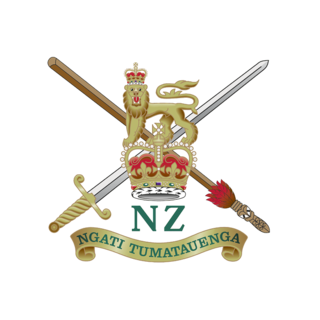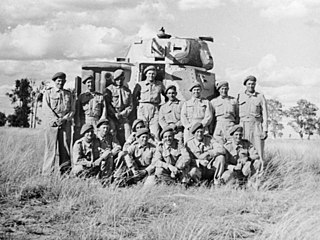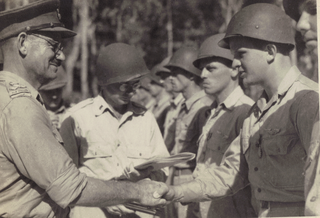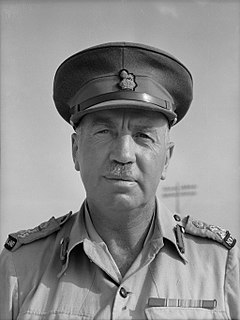The 2nd New Zealand Division, initially the New Zealand Division, was an infantry division of the New Zealand Military Forces during the Second World War. The division was commanded for most of its existence by Lieutenant-General Bernard C. Freyberg. It fought in Greece, Crete, the Western Desert and Italy. In the Western Desert Campaign, the division played a prominent role in the defeat of German and Italian forces in the Second Battle of El Alamein and the British Eighth Army's advance to Tunisia.

The New Zealand Expeditionary Force (NZEF) was the title of the military forces sent from New Zealand to fight alongside other British Empire and Dominion troops during World War I (1914–1918) and World War II (1939–1945). Ultimately, the NZEF of World War I became known as the First New Zealand Expeditionary Force. The NZEF of World War II was known as the Second New Zealand Expeditionary Force (2NZEF).

The 3rd New Zealand Division was a division of the New Zealand Military Forces. Formed in 1942, it saw action against the Japanese in the Pacific Ocean Areas during the Second World War. The division saw action in the Solomon Islands campaign during 1943–1944, during which it undertook landings on Vella Lavella, the Treasury Islands and the Green Islands. Due to manpower shortages, for most of its existence the division consisted of only two infantry brigades in addition to support personnel, with its third brigade being disbanded shortly after formation. In 1944, manpower shortages in the New Zealand economy became acute led to the disbandment of the division. The majority of its manpower was returned to civilian employment, although around 4,000 men were sent to Italy to reinforce the 2nd Division, seeing further action before the end of the war in May 1945.

Armoured units made a relatively small, but important, contribution to Australia’s war effort during World War II. While Australia formed three armoured divisions and two independent armoured brigades during the war, Australian armoured units only saw action as independent regiments and companies supporting larger infantry formations. Early actions were fought in the Middle East by the divisional carrier regiments that supported the 6th, 7th and 9th Divisions, fighting in Libya, Egypt and Syria in 1941–42, before the Australian divisions returned to Australia in 1942–43. During the early fighting in the Pacific, there was a limited role for armoured formations, although one armoured regiment – the 2/6th – took part in the fighting around Buna–Gona in late 1942. Later in the war, though, during the Huon Peninsula, Bougainville and Borneo campaigns of 1943–45, several armoured units were used by Australian forces in the infantry support role.
The 4th New Zealand Armoured Brigade was an armoured brigade of the New Zealand Military Forces, formed during the Second World War in October 1942 from the remnants of the 4th New Zealand Infantry Brigade. It was part of the 2nd New Zealand Division, which had already seen action in the Battle of Greece, the Battle of Crete and in the North African Campaign, having a leading part in the Second Battle of El Alamein. The brigade arrived in Italy in October 1943 and took part in a number of battles over the course of a sixteen-month campaign in Italy. They were equipped with Sherman and Stuart tanks, Lynx scout cars and a variety of other vehicles. The 4th Armoured Brigade was officially disbanded, after the war, in December 1945. It was reactivated briefly in the 1950s.

The Battle of Point 175 was a military engagement of the Western Desert Campaign that took place during Operation Crusader from 29 November – 1 December 1941, during the Second World War. Point 175 is a small rise just south of the Trigh Capuzzo, a desert track east of Sidi Rezegh and south of Zaafran, with a good view of the vicinity. In early November 1941, the feature was held by German infantry of Division z.b.V. Afrika. Troops of the 2nd New Zealand Division and Infantry tanks of the 1st Army Tank Brigade attacked and captured Point 175 on 23 November, during the Battle of Sidi Rezegh, at the start of Operation Crusader. The New Zealand troops then attacked westwards and made contact with the Tobruk garrison, which had broken out to meet them. From 29 November – 1 December, the New Zealanders defended the point and the area to the west against Axis attempts to sever the link with the Tobruk garrison and regain control of the local roads. The new 132nd Armoured Division Ariete re-captured Point 175 late on 29 November.
The 5th Division, New Zealand Military Forces, was raised in the Southern Military District during the Second World War. It consisted of the 3rd and 10th Brigades and the 11th Brigade Group. It was disbanded after the danger of invasion from Japan receded. It appears to have been raised on 1 November 1941, and disbanded on 1 April 1944.

The 8th Brigade was a formation of the New Zealand Military Forces, which served during the Second World War as part of the 2nd New Zealand Expeditionary Force. Eventually forming part of the 3rd Division, the brigade served in the Pacific Ocean theatre of the war. Raised in late 1940, initially the brigade was employed on garrison duties on Fiji before returning to New Zealand in mid-1942. In December 1942, it was sent to New Caledonia where they remained until early September 1943, when they moved to Guadalcanal to prepare for operations in the Solomon Islands. The brigade's only combat operation of the war came in October–November 1943, when it captured the Treasury Islands. It was disbanded in late 1944 due to manpower shortages in the New Zealand economy.

Major General Graham Beresford Parkinson, was a professional soldier in the New Zealand Military Forces who served during the First and Second World Wars.
The 21st Battalion was an infantry battalion of the New Zealand Military Forces that served during the Second World War. Formed in January 1940, it was part of the 5th Brigade, 2nd New Zealand Division of the 2nd New Zealand Expeditionary Force. The battalion saw action in Greece, Crete, North Africa and Italy before it was disbanded in December 1945.

The 20th Battalion was a formation of the New Zealand Military Forces which served, initially as an infantry battalion and then as an armoured regiment, during the Second World War as part of the 2nd New Zealand Division.
The 4th Division was one of three home defence divisions of the New Zealand Military Forces formed during World War II. The unit was established on 1 November 1941 and was responsible for protecting the southern part of New Zealand's North Island from invasion. The division was greatly reduced in size during 1943 and was disbanded on 1 April 1944 without seeing combat.

The 6th Infantry Brigade was an infantry brigade of the New Zealand Military Forces, active during World War II as part of the 2nd New Zealand Division. It saw service during the North African Campaign and the Italian Campaign before being disbanded in late 1945.

The 18th Battalion was a formation of the New Zealand Military Forces which served, initially as an infantry battalion and then as an armoured regiment, during the Second World War as part of the 2nd New Zealand Division.

The 24th Auckland Battalion was an infantry battalion of the New Zealand Army during the Second World War. The 24th Battalion was formed on 1 February 1940 and embarked for Egypt on 28 October 1940. It was part of the 6th Infantry Brigade, part of the 2nd New Zealand Division. The battalion fought in Greece, North Africa and Italy. After the conclusion of hostilities, the battalion was disbanded in December 1945.

The 25th Battalion was an infantry battalion of the New Zealand Military Forces, which served during the Second World War as part of the 6th Infantry Brigade, 2nd New Zealand Division.

The 9th Brigade was a formation of the New Zealand Military Forces raised for service in Italy during the Second World War. As part of the 2nd New Zealand Division, it participated in Operation Grapeshot in 1945. It then provided the basis of J Force, the New Zealand contribution to the British Commonwealth Occupation Force.

The New Zealand Scottish Regiment was a regiment of the New Zealand Army. It was formed in 1939 as an infantry regiment and raised two battalions during the Second World War. Although the 1st Battalion was sent overseas during the war as part of the 3rd Division, it never saw combat. The regiment was reformed in 1948 as a reconnaissance regiment of the Royal New Zealand Armoured Corps, but by the 1960s had been reduced to two independent squadrons. Various armoured vehicles were utilized by the regiment including Daimler Dingo Scout Cars, Daimler Armoured Cars, Ferret armoured cars and M113a1 armoured personnel carriers. The regiment was eventually disbanded in 2013.

The Waikato Regiment was a territorial infantry regiment of the New Zealand Military Forces. The Regiment was formed in 1911 as the 16th (Waikato) Regiment and provided service companies to the Auckland Infantry Regiment during the First World War. Men from the Regiment also served with the 18th, 21st, 24th and 29th battalions of the 2nd New Zealand Expeditionary Force during the Second World War. The regiment was absorbed by the 1st Armoured Regiment (Waikato) of the Royal New Zealand Armoured Corps in 1950













